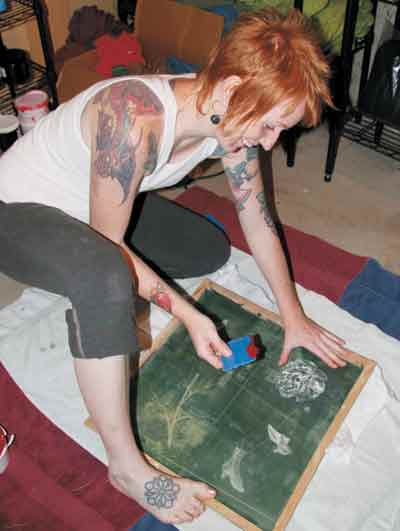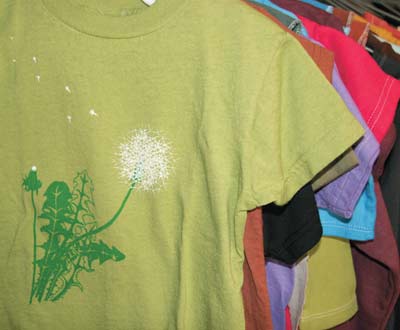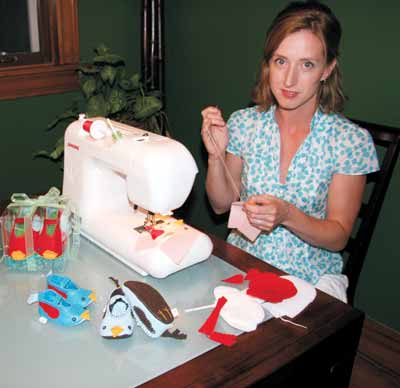A hundred Utah crafters have shops in the online world of Etsy, a thrilling aggregate of art festival, farmers’ market, gallery stroll and hipster craft bazaar the size of a small city.
by Amy Tullius
 I come upon Etsy by chance. A friend sends me a link, and when I log on, I am shocked by what I find: a giant online marketplace where artists from around the world sell their crafts. It is like wandering into a thrilling aggregate of the Art Festival, Farmer’s Market, gallery stroll, and a hipster craft bazaar the size of a small city.
I come upon Etsy by chance. A friend sends me a link, and when I log on, I am shocked by what I find: a giant online marketplace where artists from around the world sell their crafts. It is like wandering into a thrilling aggregate of the Art Festival, Farmer’s Market, gallery stroll, and a hipster craft bazaar the size of a small city.
I am first struck by the site’s innovative and delightful search interfaces. You can search by color: mouse over a field of colored bubbles and click on, say, tomato red. Ten windows pop up with tomato red journals, rings, cardholders, and paintings. More structured shopping options like categories of crafts or gift guides help navigate the daunting number of shops if you’re not such a follow-your-nose kind of shopper. Etsy members also curate groupings of favorite items—almost like craft mix-tapes—and post them on the treasury page. You can shop Etsy by geography—whiz around the globe using the geolocator interface and click randomly to find art in, say, Iceland or maybe Puerto Rico.
Etsy is fascinating, inspiring and completely addictive—it provides some of the most exhilarating shopping I’ve ever done. But it’s more than that. Etsy is the antidote for the blasé monodesign of late model capitalism: it is wildly diverse, creative, and exciting.
Etsy’s founder Robert Kalin created the site as cure for the meaninglessness of modern shopping. “The web completely changes the way that world commerce works,” he says. “Etsy as a whole is providing viable alternatives to shopping at places like Wal-Mart.” Kalin also says that the “human-to-human relationship of the person who’s making and selling [a product] to the person who is buying it is at the core of what Etsy is.” Sales are between buyer and seller on Etsy, with the site taking only 3.5% of each sale. Contrast that to selling in a retail environment, where an artist would expect to pay a 40-50% commission to the boutique. Local artist Dana Robison, creator of Piddies baby slippers, says that when she joined Etsy, it “opened my eyes to the fact that everything we purchase doesn’t have to be mass-produced under conditions most of us wouldn’t condone. Etsy has made me mindful of the amount of work and time that goes into handmade products, and the value in supporting artists and artisans who are not mass-producing their products but are making each one by hand.” 
If such a thing is possible, Etsy is a kind of socialized capitalism. It is ethical capitalism that respects all parties involved in the transaction: first and foremost the artist, the buyer, and then the greater community of sellers and buyers. It provides not just beautiful art and products, but a warm sense of community and belonging to one’s world. Even though you have access to and are connecting with craftspeople from around the country and the globe, it feels as if it is a small community.
But what about our local community?
Back to the great Etsy search interfaces. I click the link for “shop local” and type in “Utah.” One hundred of the most recently updated shops pop up featuring crochet hats, photography, leather journals, baby booties, cards, beadwork, buttons, and handbags. If I were only to shop in Utah, Etsy would be a treasure. Here are a few of my favorite finds:
Full Spectrum & Beanchild
www.etsy.com/shop.php?user_id=5305402
Full Spectrum and Beanchild are the screenprinted clothing shops of Sonya Evans, an artist out of Clinton, Utah who taught herself to screenprint while she was living in Oregon so that she could work from home while her daughter was young. She started out selling her work at farmer’s markets until a friend told her about Etsy.
Her designs are edgy and graphic, featuring unexpected hand-screenprinted octopi and jellyfish, 10-speeds, and pinking shears on tee shirts, bags, pillow covers, and tea towels.
Beanchild, the children’s clothing counterpart of the Full Spectrum, is a line of screenprinted baby clothes including a skull and crossbones black cotton diaper cover, a newborn onesie with a red antennaed shrimp across the tummy, and itty little hoodies with angel wings.
Sonya says that becoming a part of Etsy made her want to buy everything handmade and local. “Buying things that are not handmade feels meaningless now,” she says.
She says she never expected the business to become so successful. Her Etsy shop has brought her national attention, from a review in a New Jersey newspaper to a contact from Rachel Ray’s PR people to see if she’d like to send over an owl tee shirt to be featured in the magazine. She’s had international sales lately from as far as Russia, Germany and Norway, and gets orders all the time from the UK and Australia. “That’s all from being on Etsy. Otherwise, I was just in a little booth by myself in Eugene, Oregon.”
 Piddies
Piddies
www.etsy.com/shop.php?user_id=5445160
Piddies might be the cutest things in the world. Dana Robison handsews and embroiders these sweet little baby slippers out of her home near Liberty Park in Salt Lake. She opened her Etsy shop just last November and put up 10 pairs of slippers to see what happened. The first pair sold within an hour.
I ask if she’d sold her work before Etsy, and she tells me “no, but I have been sewing, crocheting, crafting, and building all of my life and have always had an entrepreneurial spirit. I’ve always asked myself, ‘would there be a market for this?’ when I created something I felt was unique.” Etsy has given her a marketplace to test the waters without much risk. She custom makes each pair of slippers as they’re ordered, so demand drives her production.
Her slippers are mostly birds, darling felt bird mary janes with blanket stitches along the edges, and stick-out wings, beaks and tails. There are chartreuse baby bird slippers with turquoise wings and tail, a little orange beak, and tiny perfect embroidered yellow feet on the bellies/soles. She has red and green parrot slippers, little yellow chicken slippers, and sweet little orange goldfish slippers with kissy red lips and blue bubbles embroidered on the bottom.
Dana tells me that she was amazed at the friendliness and supportiveness of the Etsy community. “From the very first day,” she says, “there were people coming out of the woodwork to encourage me.”
Romy Brett
www.etsy.com/shop.php?user_id=21595
Romy B started out just shopping on Etsy, but after a couple of months, decided to open her own shop. She had met several of the artists in the community through the “contact” section, and the people she met made it easy for her to get started. “One made my logo,” she says, “another made my icon, another helped with business cards. There is a PIF section (pay it forward) where others get good karma for helping me. At that point I started listing items.” (After she tells me this, I do a search on Etsy for “pay it forward” and it’s true! Six pages of free or donated items and services pop up. The idea is that the kindness is catching.)
Romy B’s shop includes tiny pictures of power women—Wonder Woman, Marilyn Monroe, Frida Kahlo, and the Virgin of Guadalupe (to name a few)—in the wee circular frames of magnetized bottle caps. She also has hand-painted tiny drawings in bottle cap frames, Madonna and glitter-encrusted matchbooks, and whimsical stuffed plush critters. In addition to her Etsy shop she sells at galleries around the nation, and locally at the Women’s Art Center, the Blue Cockatoo, Utah Artists Hands, the Artspace City Center basement patio during gallery stroll and at the Salt Lake Farmers’ Market.
Dirty Bird
www.etsy.com/shop.php?user_id=5248376
Remember the scene in Fritz Lang’s 1927 silent movie masterpiece “Metropolis” when the robot woman is revealed and comes to life? Dirty Bird’s Metropolis photo bracelet includes a still of that scene as well as three other stills from the film captured in glass and silver. Perhaps you’re into zeppelins: Now you can have four glass-encased images of dirigibles silently drifting, launching, and elegantly crashing in flame for all time around your wrist. Old anatomy illustrations? Dirty Bird has you covered. Lovely and haunting, the bracelets are attractive from a distance, and fascinating up close.
Melissa Dallof is the force behind the shop—which she says is more of a hobby than anything else. She’s in her final year of law school, and making the jewelry is a fun side project and creative outlet. Dallof says she has been surprised by the items that have been successful in her Etsy shop. “Etsy reaches such a large audience,” she says, “you can do something unusual and somebody out there will like it. I think I’m going to add a photo bracelet of different Eames chairs. And seriously, in my circle of acquaintances, how many people are going to say ‘Oooh, Eames chair jewelry!’ or be excited about jewelry made from old films? But on Etsy, there are people who share my weird little fixations.”
Lii Lii
www.etsy.com/shop.php?user_id=5061740
Lii Lii is the work of Yvette Daley, another Salt Lake City artist. Lii Lii is a vast Etsy store featuring jewelry made of vintage Scrabble pieces decoupaged in decorative bits of beautiful paper. Flipping through her hundreds of necklaces and earrings, one is lured by blackbirds, arts and crafts daisies, a printed honeybee diagram, Japanese owls, brown blossoms against a blue sky, 1920s floral wallpaper designs, china patterns, and tiny Eiffel Towers.
Yvette says she was also surprised at how friendly the Etsy community is. She says that “people want to include me, as the maker of their jewelry, in their purchase experience. They write to me to tell me about an experience they had while wearing one of my pieces of jewelry. They send me pictures to show me how they look wearing my jewelry. I sometimes get emails months later from customers who want to let me know they are still wearing their jewelry and loving it.”
ByKali
www.etsy.com/shop.php?user_id=5418707
When I first talked with Kali Mellus, she was in the process of transitioning from a physical shop to an almost exclusively online business. When she wasn’t sure if she would be able to renew her shop lease, she decided to take the business online, work from home, and use Etsy as the main venue for selling her work.
Kali’s art is industrial but elegant: she makes necklaces and belt buckles with pins, nails, staples and washers imbedded in layers of resin. I’ve been a fan of her stuff for quite some time, so it was disappointing for me to hear that she was closing her Pierpont gallery. But when I caught up with her a few months later, she told me, “As far as this Etsy thing goes. I could not have expected it to go as well as it has. I was the featured seller about a month ago and since then I have sold over 100 pieces.” She told me she was nervous about closing her gallery, so signed up for various summer festivals and local markets, and is now having to sprint to keep up with the demand for her work.
Certainly Etsy is not a substitute for going out and buying art from local shops and art festivals, but it is a great way for local artists to maintain creativity and autonomy while taking their business to a larger audience, and it is a way to nurture the creativity and diversity of people in the rest of the world. It is a global community based on respect for kindness and each artist’s uniqueness. Shop local, think global? On Etsy, it’s almost the same thing.
Amie Tullius is a short story writer, essayist, and lover of the arts. She is a recent transplant from San Fransisco, where she completed an MFA in writing at the California College of the Arts. She now lives in Park City with her fiance and dogs.
